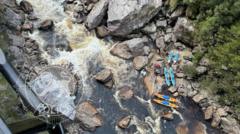A tourist in his 60s endured a catastrophic accident while kayaking in Tasmania, resulting in a leg amputation during a dangerous 20-hour rescue effort amidst raging waters.
Tourist Faces Leg Amputation After Harrowing Rescue in Tasmanian River

Tourist Faces Leg Amputation After Harrowing Rescue in Tasmanian River
A kayaking accident in Tasmania leads to a life-saving amputation amid treacherous conditions.
A kayaking trip in Tasmania turned into a nightmare when a tourist in his 60s found himself trapped between rocks in a raging river, ultimately leading to an emergency leg amputation during a dramatic rescue operation. The incident unfolded on the Franklin River while the man was scouting the terrain, where he slipped and fell into a rock crevice.
Emergency services were alerted after the man's smartwatch sent out a distress signal, prompting a race against time to save him. Rescuers spent hours trying to extract him from the perilous location but faced constant challenges due to the turbulent waters. As his condition deteriorated, medics made the difficult decision to amputate his leg to facilitate a quicker extraction. "This was a life and death situation," said Doug Oosterloo, acting assistant commissioner at Tasmania Police.
The rescue operation, characterized by extreme technical challenges and complex maneuvers, highlighted the precarious nature of the situation. The man remained partially submerged, and had he stayed trapped any longer, he would not have survived. Despite being well-prepared for the kayaking trip, he was not ready for the severe conditions he encountered.
The group of 10 fellow kayakers who were with the man when the accident occurred will undergo interviews by police to understand the sequence of events that led to the incident. According to Oosterloo, the accident occurred while the kayaker had briefly exited the water to explore the rocky area, emphasizing the unforeseen dangers that can arise in such environments.
Currently, the tourist is receiving medical care in a hospital, where he remains in critical condition. This harrowing experience underscores the risks associated with outdoor activities, particularly in wild and unpredictable settings.





















